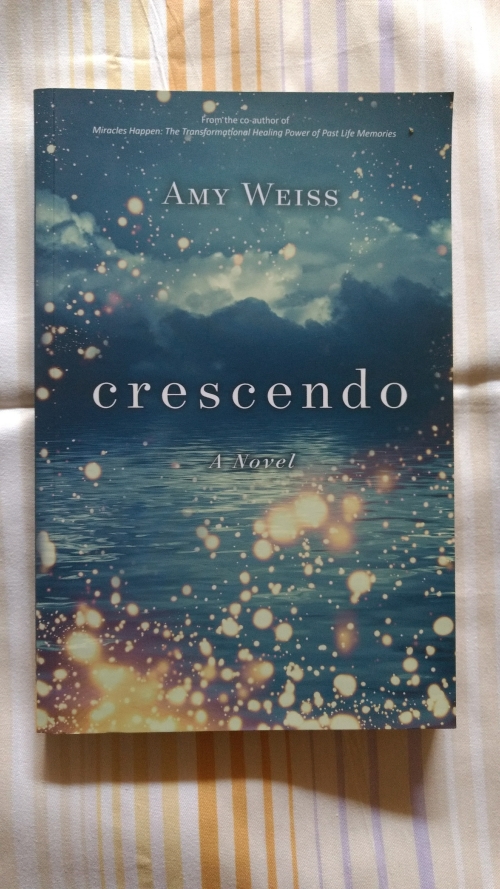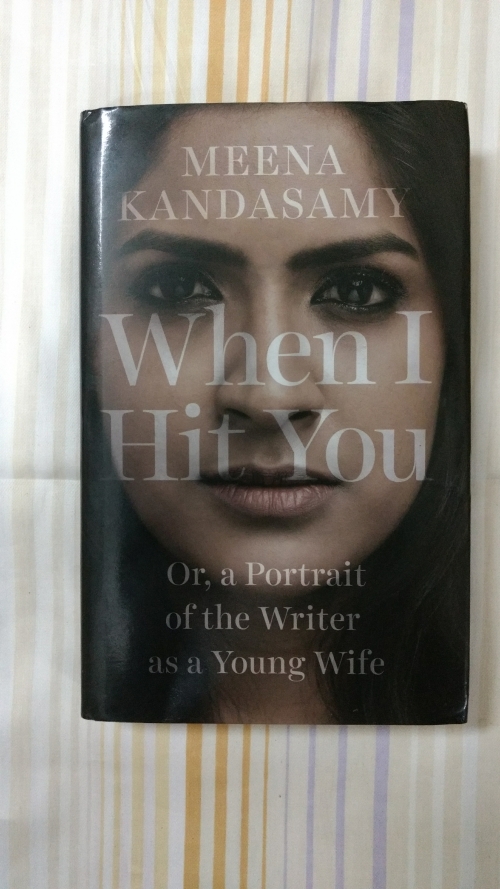I discovered ‘Crescendo‘ by Amy Weiss accidentally in the bookshop while I was browsing there a few weeks back. I tried putting it back but the description on the back cover pulled me and I couldn’t resist it. Did a long readathon yesterday and finished reading it.
‘Crescendo‘ is a story of love, loss, grief and love regained. The main character is an unnamed woman who is married and she and her husband love each other very much. She is also pregnant, which adds to their happiness. Of course, this kind of idyllic beginning always portends something dark. And disaster arrives soon and the woman’s husband and unborn baby are taken away. The woman grieves for them. She has a mare to keep her company. Then one day she leaves her place with her mare, and goes on a long journey. On her journey she meets interesting and wise people who share their wisdom with her, as she tries to understand life, love, loss, death and whether there is meaning to all this.
‘Crescendo’ is a beautiful book. It is like a fairytale for grownups or like a spiritual fable The first three chapters which are about love, loss and grief were incredibly beautiful. There were beautiful descriptions and images in every page and Amy Weiss’ soft prose was an absolute delight to read. It is not a book that you read fast like a mystery or a thriller, but it is a book that you read slowly and linger on every sentence, paragraph and page. After three chapters, the book changes a little bit. An old man makes his appearance, as he normally does in a fable like this, and shares his spiritual wisdom. It is still beautiful and there are many beautiful passages, but it has a prescriptive quality and depending on one’s world view, one might agree with it or not. If you are a spiritual person, you will love it. The quest that the main character goes through resembles the Orpheus-Eurydice myth, though in this case, it is the reverse of that, because the Eurydice of this book goes in search of Orpheus. There are also references in the book to String theory, Many worlds theory, Big Bang theory, Theory of Evolution and other such interesting things. Some of them are easy to spot while others are subtly and deeply embedded in the story. Amy Weiss follows the golden rule, ‘show-don’t-tell’, pretty well. There is even an origin-of-the-universe myth which bears an oriental Hinduism flavour to it. The ending of the story is interesting – it touches on the non-linear, circular aspect of time and has a James Joycean flavour to it.
One of the beautiful things I loved about the book was the structure of the book. Each chapter is titled after a musical concept related to musical theory, technique and form. There is something in that chapter (or sometimes even the whole chapter) related to that particular musical concept. And as our heroine goes through her quest in life, we see it through musical eyes, and the whole book feels like the story of a symphony – how a symphony is born and takes shape with beautiful notes which after some interesting experiments fall into the right places to form beautiful melodies and how this symphony evolves and becomes the complex musical being it is meant to be and how it is unfurled, in the end, in all its musical glory. It is incredibly beautiful to read and experience.
I loved ‘Crescendo‘. Amy Weiss follows in the long hallowed tradition of authors like Kahlil Gibran, Richard Bach, Robert Pirsig, Paulo Coelho and Mitch Albom, and has written a beautiful spiritual fable, a fairytale for grownups, which addresses all the big questions in it – love, loss, longing, grief, the meaning of life, the true nature of time, the deep bond between humans and animals. Amy Weiss’ soft prose is beautiful and lyrical and luminous and a delight to read. The book can be read for that alone. One of the reviewers said this about the book, a passage which I absolutely loved – “Crescendo is a lyrical travel tale, a myth, a map, a parable – all of these and more. Amy Weiss has the skill of a poet, the dramatic flair of a storyteller, and the heart of a mystic. This little book is lit from within – lit with intelligence, spirit, hope, and mystery. Weiss weaves a spell that caught me in its luminous threads from the first word to the last. I feel expanded having gone on the journey of Crescendo.” If you like spiritual fables and fairytales for grownups, you will like this.
I will leave you with some of my favourite passages from the book.
“That’s much too sad,” he says. “Sing me a love song instead.”
As if every word she speaks is not a love song. As if there is not a love song in the way she looks at him, in his hands creating curls in her hair, in the touch of her cheek against his. A love song that has begun to form in her belly and that will, in due time, swell inside it. As if, each time he gazes at her, he is not sight-reading the music of her face. It is how they communicate, in that language of silence and sound. In the evenings they play together in the barn, where her harp tells of the quiet, naked things that hide within her heart, and his guitar shares secrets he did not know he had. They talk late into the night, their conversations becoming lullabies that send the mare, sleeping nearby, into dreams filled with desire and stallions and God.Without stopping, she leans against an oak, unaware that it is listening. Though the oak is a strong, stoic type, it is deeply moved by the woman and the gentleness with which she cradles the harp. It is mesmerized by the strange spell her hands cast over the wood : transforming a tree into melody, making it sing. It yearns to feel her fingers brush against its own body, to hear the sound she could coax from its silence. Leaves fall from its branches, flutter around her, surround her in a sea of longing. The cardinals and starlings perched in its hollows cock their heads and stare. They have never known the oak to cry; who has seen their house shed tears? Their songs are also made of light – a different one, a gilded one, which erupts from their little bird bodies when they can no longer contain it’s force – yet they are unfamiliar with sorrow. Only the mourning dove knows it’s dreary refrain.
A book belongs inside and beyond time and space. A reader can dip into its pages and swim in its words, put it down, walk away, come back to it years later, come back to it even after its author has died. It alters the consciousness and the heart, yet its effects do not varnish when its cover is closed, when it is returned to the shelf, when its events are purely fictional and never physical. The book itself may be destroyed, its words erased or struck from the page – but not from the reader. The material world is the same. Reality can disperse with the wave of the old man’s hand, the illumination of the woman’s mind. The medium comes and goes. The insight remains.
“To become louder, to become quieter, to discover the strength in the softness : these are means of expression in music, and they are what move the listener. Beauty is born from the dynamics. Power has its own dynamics, and it too can be played both ‘forte‘ and ‘pianissimo possibile‘, as soft as possible.”
“Soft power?”
“Yes, like a butterfly. No one expects it to be a firecracker. It wouldn’t be a butterfly if it were, and it would devastate the flowers upon which it lands. Nevertheless, the power inherent inside it – to accept the dark days, knowing that they are when transformation occurs; to honor the time it takes for one’s wings to dry; to slough off the weight of its past and fly, when all its life it has known only to crawl – is far more explosive than any firecracker. Soft can be so much stronger than hard.”
Have you read Amy Weiss‘ ‘Crescendo‘? What do you think about it?







